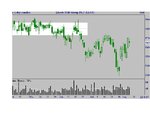barjon
Legendary member
- Messages
- 10,752
- Likes
- 1,863
ok, slightly different slant to this one.
Please don't try to identify the instrument - I've removed prices as well to make that more difficult :cheesy: - just take it as you see it.
To give overall context for Tony, the first chart is a weekly chart; additionally the market overall had been rising steadily and had just retreated from a new high and gone down to breach it's last swing low at a time coincident with the "on the close" downward break seen on the daily chart of the instrument in question.
Right, our intrepid trader has watched this instrument fail to make new highs on the weekly chart after a fall from new highs that breached an earlier swing low although the 50ma is still rising (naughty boy might be about to ignore one of his conditions here 😱 ).
Mostly, however, he is intrigued by the 36 bars long congestion zone which is fairly tight on a closing basis. He wants to trade a break out from that zone. He enters short at the red line after such a breakout which persisted on the close for 4 bars. He has not set a stop but has it in mind to exit at the best price available following a close above the congestion zone - that'd be about 20 points at best.
The next day starts well but finishes printing a hammer on fairly high volume with a close very near his entry level. The next day worse - a gap opening and a close back in the congestion zone. He is underwater now, but only at the shallow end. The next day - our cut off point on the chart - another upward gap opening but the price doesn't hold and drops albeit still a higher close. It's on very high volume too, but the water's got deeper.
Gulp, what's he going to do now? He's still not near his stop loss area, but should he wait any longer or would getting out just be a panic move? Decisions, decisions.
So, guys, wot next?. How would you take it from here and advise our hapless friend?
good trading
jon
Please don't try to identify the instrument - I've removed prices as well to make that more difficult :cheesy: - just take it as you see it.
To give overall context for Tony, the first chart is a weekly chart; additionally the market overall had been rising steadily and had just retreated from a new high and gone down to breach it's last swing low at a time coincident with the "on the close" downward break seen on the daily chart of the instrument in question.
Right, our intrepid trader has watched this instrument fail to make new highs on the weekly chart after a fall from new highs that breached an earlier swing low although the 50ma is still rising (naughty boy might be about to ignore one of his conditions here 😱 ).
Mostly, however, he is intrigued by the 36 bars long congestion zone which is fairly tight on a closing basis. He wants to trade a break out from that zone. He enters short at the red line after such a breakout which persisted on the close for 4 bars. He has not set a stop but has it in mind to exit at the best price available following a close above the congestion zone - that'd be about 20 points at best.
The next day starts well but finishes printing a hammer on fairly high volume with a close very near his entry level. The next day worse - a gap opening and a close back in the congestion zone. He is underwater now, but only at the shallow end. The next day - our cut off point on the chart - another upward gap opening but the price doesn't hold and drops albeit still a higher close. It's on very high volume too, but the water's got deeper.
Gulp, what's he going to do now? He's still not near his stop loss area, but should he wait any longer or would getting out just be a panic move? Decisions, decisions.
So, guys, wot next?. How would you take it from here and advise our hapless friend?
good trading
jon




